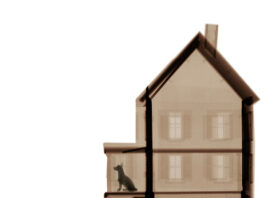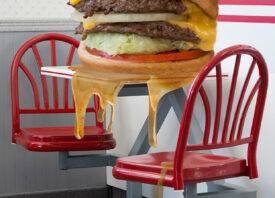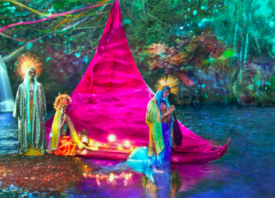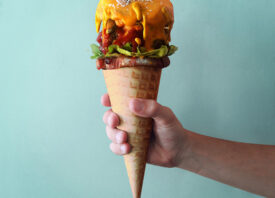Search this site
Looking at San Francisco Through Hamburger Eyes

Mark Murrmann

Ted Pushinsky
Back in 2001, brothers Ray and David Potes were putting out photo zines the old fashioned way. Ray would edit and art direct while Dave ran copies while working in a college copy department. The one titled Hamburger Eyes really stood out — and began attracting photographers who wanted to share their work.
Ray, who was living in Hawaii at the start, moved to San Francisco where David was, and the city became home base for a vital street photography culture that recalled the glory of Garry Winogrand and Joel Meyerowitz.
Hamburger Eyes that quickly became a cult sensation in the photo underground, as the classic black and white format made the strange and mundane scenes of daily life all the more profound. In its back to basic approach, Hamburger Eyes elevated the photo zine into a work of art.
Over the years, Hamburger Eyes has gone on to publish 37 issues, as well as over 200 titles by artists, as well as two books — their latest SF Eyes: The Continuing Story of Life, Loss, Tragedy, and Triumph in the City of San Francisco as Captured by the All-Seeing Lens of Hamburger Eyes Photography Magazine just released by Hat & Beard Press in conjunction with a documentary film produced by Aaron Rose.
SF Eyes is a picture perfect postcard of San Francisco, when it was punk AF by crew members Jason Roberts Dobrin, Kappy, Dylan Maddux, Alex Martinez, Mark Murrmann, Ted Pushinsky, Andrea Sonnenberg, Stefan Simikich, and Tobin Yelland, among others.
Hamburger Eyes spent its formative years in San Francisco, becoming an integral part of the scene. With the sweeping changes to the city, and to photography as a whole, most of the crew have decamped, but the love for the town never grows old.
To celebrate two decades of San Francisco street photography, we have brought together some of the artists at the core to share the continuing story of Hamburger Eyes.

“My brother and I were making zines since high school and we stuck to this one and it worked out. When we started there weren’t any photo zines at that time. I remember handing one of he first issues to my friend and he said, ‘I don’t know how this makes me feel or think.’
“There were no words. It was perfect. And I knew we were doing something good. We were provoking some kind of thought or emotion, I don’t know. Throughout the years the issues and the content evolved.
“Back then we didn’t know what were doing. We were just having fun, doing what we wanted to do. We had no idea what it would become now, the pathways, the books, the group shows, museums — it’s not what we intended.
“We started Xeroxed stapled and bumped up to offset printing, perfect bound with incredible photographs. I remember that step and holding that first issue and being blown away. It was like an actual photo book. It wasn’t a zine or a magazine.
“We didn’t go to school for anything, so at the same time we were inspired by other photo groups like Magnum. We’re more than a photo zine — we consider ourselves a photo gang. I moved to an Francisco in 2001. I felt like the aftermath of the first dot com crash was a new era. Going out, shooting photos, starting Hamburger Eyes, meeting all these other photographers, skaters, graff kids who shoot too — being a community of wastoids. It’s great, those are my people (laughs).
“At that time, San Francisco was cutty. Now it’s the most expensive place to live in the country. That time was wild. The energy was raw. We had sick parties! People got lit. We were on Haight-Ashbury smoking blunts. You can’t really do that anymore.”

“I met Dave and Ray as friends. We were all neighbors in the Mission. I realized they were photographers. Our crew was a lot of skateboarders. I was into freestyle biking and BMX, punk rock, and those both had zines so as an adult to meet people who were down for the same things I looked up to, it was a perfect match.
“San Francisco was the mecca for skateboarding. Every hometown has those internal weirdos who gravitate here. Real recognize real. Graffiti writers, skaters, bikers, messengers, artists, and rappers do have some commonalities to them, and they acknowledge each other now.
“I came out to San Francisco in 1998. Same neighborhood the whole time – maybe four different apartments in Channel 24. I love it. I am a big fish in a little pond. I’ve been here to see it go from a ghost town to a hot spot and the changes that have come with that are disgusting — it’s money, It’s a shame.
“Hamburger Eyes was a nucleus. I’ve seen it go from a living room operation to the famous Lab, the photo-processing center that was run off 24th Street. The people that would come through there were amazing. The photo shows were ragers, for sure, and it gave a social scene to a lot of people and exposed people to things they might not have sought out.
“The book is dedicated to Ted Pushinsky. He was instrumental in influencing San Francisco street photography. I may get two books: one to rip the photos out and one to keep. I have one on my wall framed, the kids sitting on the stoop. It’s across from my bed. Seeing the photos, meeting the photographers, and clicking — no pun intended. It’s nice to meet someone who created something you like and to not be let down, to actually be stoked.”

“Ray sent me an email out of the blue and told me he was doing a zine and asked if I wanted to submit photos — and the rest is history. I had a website and was posting band photos on music websites and doing stuff for Maximum Rock & Roll, but I’m not sure how he found me.
“I was living in Berkeley at the time. I moved out here in ‘98 and it felt like a playground. There were a lot of bands. They would have generator shows and play on the street until the cops broke it up, a lot of warehouse spaces and shitty bars, and people skating in the city.
“Since I just moved here everything was new, crazy, and fun. My eyes felt open all the time. I couldn’t get enough of it. The city was really inspiring. There was a lot happening al the time. I ‘d go out to shows 4-5 times a week. When I was taking pictures I would be the only person at a show with a camera. The period covering in SF Eyes was before everyone was taking pictures.
“One of the most amazing things, there’s a photo of a show at a Kinko’s that I took in 1998. Someone who worked at Kinko’s, it was her last night and she was quitting. She worked the graveyard shift, invited bands to play, and opened the copy machines so people were making zines from like midnight til 4. It was such a magic moment. The Kinko’s was filled with people. Once it was over, the plce was trashed and everyone helped clean it up so it looked like nothing ever happened.
“Looking at my photos, the ones that stand out for me that have a certain resonance are some of the band photos I took. It feels so special to be at these tiny shows where you are literally a foot away from the band and the energy is so exciting. Being able to capture that in a picture, where it makes you feel like you are right there getting beer spilled on you and the singer spitting on you from the proximity and closeness, that feeling I miss.”

“I moved to San Francisco in 2001. It was the place to be at the time. The week I moved out someone quit at Gamma Black and White, a really good b/w lab in SF, and I got a job working there.
“When I first moved there, everyone would be having bonfires on the beach because all their companies went bankrupt and they would be burning their papers. Everybody was leaving. It was a fantastic time. You were either a young punk kid, a homeless person, or just making it by. It was a blue-collar town.
“All my friends moved for skateboarding; I moved for the arts. That whole world came together. I met Ray and the crew, and they knew I worked at a photo lab and I was the go to guy for questions or processing. You could come to me any time, anything they needed I would do it for free.
“It wasn’t just photographers, it was the community. There were people in every genre of the arts. A lot of the pictures are from openings of Hamburger Eyes art shows. All of us would hang out outside the party. They had free beer. That was the place.
“We didn’t know what we were doing and we didn’t care. My rent was $250 a month. I didn’t need money. There were eight of us in the house. We were all artists and musicians. We were all in a band together; American River was the Hamburger Eyes band. We would play at all the openings. It was all I needed. It was a magical point.
“To be a street photographer now is so different. Back then, we were all degenerates, we were all the people left behind that came in when everybody left.”

“I had made a bunch of zines of all different titles and one say I was like I am going to make one called Hamburger Eyes. The name was a slang term we used, like, ‘Go talk to that girl she’s giving you hamburger eyes.’ For some reason it got a lot of attention compared to my others and I think it is because I mostly put pictures of my friends.
“It started off with friends of friends, friends of friends of friends, and random people emailing me asking how they can get their photos in there, which is like whoa — flattering!
“I had moved there in 2002 or 2003, and that was the peak of me wanting to do things on film. I was out every day, young, trying to see how things looked photographed. That’s how I met the other guys doing the same thing.
“A lot of the photographers in the book are still shooting everyday in SF. I didn’t want to paint a picture like San Francisco was a certain way and now it’s all gone. A lot of the photos are brand new shot this year. The diversity of people in close quarters with each other makes it a great city to shoot.
“The book is dedicated to Ted Pushinksky. When I first met Ted, I lived at my brother’s place on the couch. It was a three-bedroom place, with two dogs, and 8 people, and I was making Hamburger Eyes in the living room. Ted came over one day (we don’t know how he got the address), and said, ‘I like Hamburger Eyes! I want to give you some photos.’
“We said, ‘Okay, you have to scan them and burn them on a CD.’ He was like, ‘How do I do that?’ Dave helped him and he brought the disk over. The magazine was already at the print shop and we were willing to hold it because we saw Ted’s photos and they had to be in there. And then the CD was blank! So many things like that at the beginning of Hamburger Eyes were like that: very hectic, and things never worked out, but they always worked out.
“The darkroom that Stephan and I hung out all the time. The owner was like do you want to buy some equipment, and she told us she was closing, and we asked about renting the office and helping her as partners. This part a bookstore and gallery, and eventually we just took over the place. it was fun gut it was a lot of work, with a lot of existing bills she couldn’t make. At the same time it was the birth of digital printing and photography, it was hard to pay the bills but super fun hanging out with people.
“Days go by where you are like, ‘all my bills are due. Should I just go work at Fed Ex?” Then another publisher comes along and wants to publish your old photos. Those are the treats, and meeting photographers. I still get emails from photographers who want to contribute. I don’t know when the next issue is coming out and I have to make time — but it turns out to always be worth it.”

Ted Pushinsky

David Potes

Ray Potes

Kappy
All images: © the photographer, courtesy of Hat & Beard Press



